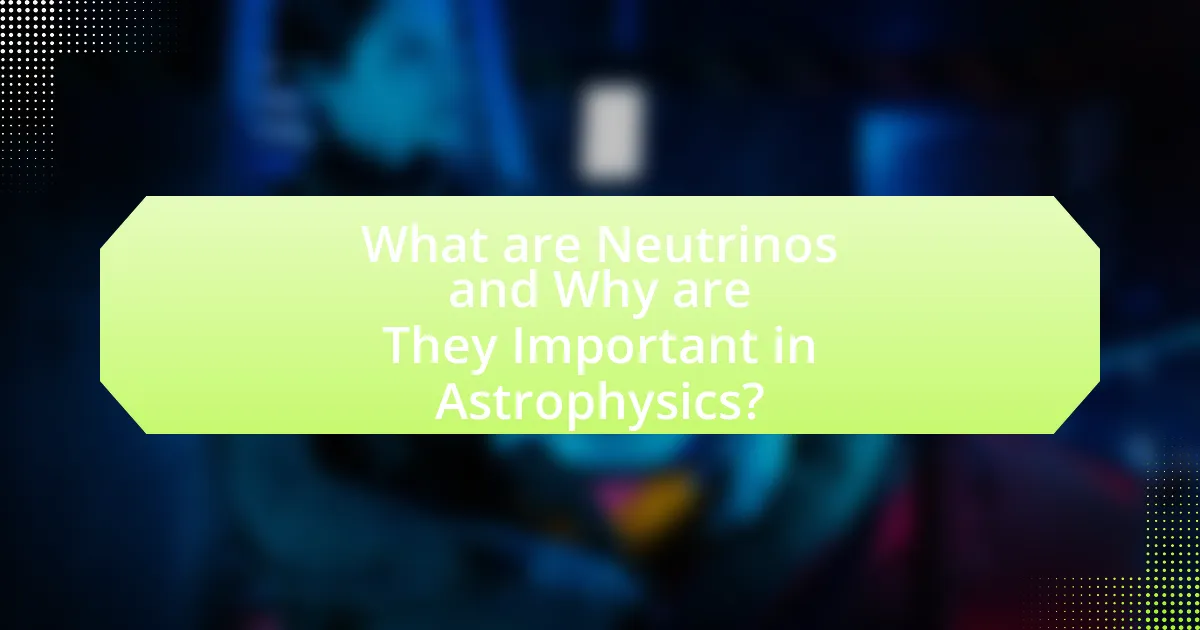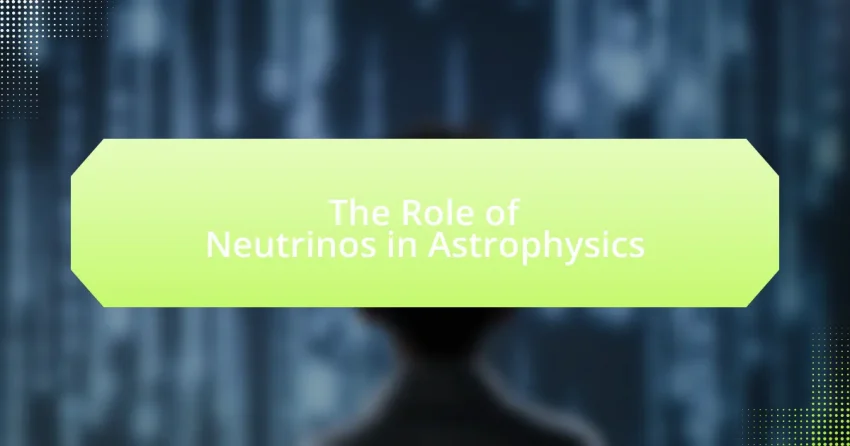Neutrinos are subatomic particles with negligible mass and no electric charge, generated in nuclear reactions such as those in stars and during supernovae. Their unique properties, including weak interaction with matter and the ability to oscillate between different types, make them crucial for understanding astrophysical phenomena. This article explores the significance of neutrinos in astrophysics, detailing their production in stellar processes, their role in cosmic events like supernovae, and the challenges associated with their detection. Additionally, it discusses future research prospects and potential applications of neutrino studies in advancing our knowledge of fundamental physics and cosmology.

What are Neutrinos and Why are They Important in Astrophysics?
Neutrinos are subatomic particles with a very small mass and no electric charge, produced in nuclear reactions, such as those occurring in the sun and during supernova explosions. Their importance in astrophysics lies in their ability to provide insights into fundamental processes in the universe, as they can escape dense environments where other particles cannot, allowing scientists to study phenomena like stellar evolution and the behavior of supernovae. For instance, the detection of neutrinos from the 1987 supernova SN 1987A provided critical information about the explosion mechanism and the properties of the progenitor star.
How do Neutrinos differ from other subatomic particles?
Neutrinos differ from other subatomic particles primarily due to their extremely small mass and weak interaction with matter. Unlike protons and neutrons, which are baryons and make up atomic nuclei, neutrinos are leptons and do not participate in strong nuclear interactions. This weak interaction allows neutrinos to pass through ordinary matter almost undetected; for instance, trillions of neutrinos from the Sun pass through a human body every second without any interaction. Additionally, neutrinos come in three types or “flavors”—electron, muon, and tau neutrinos—each associated with their corresponding charged leptons. This unique combination of properties makes neutrinos essential for understanding processes in astrophysics, such as supernova explosions and the behavior of cosmic rays.
What are the unique properties of Neutrinos?
Neutrinos are unique subatomic particles characterized by their extremely small mass, neutral charge, and weak interaction with matter. These properties allow neutrinos to pass through ordinary matter with minimal interaction, making them difficult to detect. For instance, trillions of neutrinos from the Sun pass through the Earth every second without any noticeable effect. Additionally, neutrinos exhibit a phenomenon known as oscillation, where they can change from one type (or flavor) to another as they travel, which has been confirmed by experiments such as those conducted by the Super-Kamiokande collaboration in Japan. This oscillation indicates that neutrinos have mass, albeit very small, which was a significant discovery in particle physics.
Why are Neutrinos difficult to detect?
Neutrinos are difficult to detect because they interact very weakly with matter. This weak interaction means that neutrinos can pass through entire planets without being absorbed or deflected. For instance, it is estimated that a neutrino can travel through a light-year of lead without interacting with a single atom. This property necessitates the use of large and sensitive detectors, often located deep underground or underwater, to capture the rare instances when neutrinos do interact with other particles.
What role do Neutrinos play in cosmic events?
Neutrinos play a crucial role in cosmic events by serving as key messengers that provide insights into high-energy astrophysical processes. These nearly massless particles are produced in vast quantities during explosive events such as supernovae, gamma-ray bursts, and the merging of neutron stars. For instance, the detection of neutrinos from the 1987 supernova SN 1987A allowed scientists to confirm theoretical predictions about stellar collapse and nucleosynthesis. Additionally, neutrinos can escape dense environments where light cannot, enabling them to carry information about the core processes of these cosmic phenomena directly to Earth. This unique property makes neutrinos essential for understanding the fundamental mechanisms driving the universe’s most energetic events.
How are Neutrinos produced in stellar processes?
Neutrinos are produced in stellar processes primarily through nuclear fusion reactions in stars. During fusion, hydrogen nuclei combine to form helium, releasing energy and generating neutrinos as byproducts, particularly in the proton-proton chain reaction and the CNO cycle. For instance, in the proton-proton chain, two protons fuse to form deuterium, releasing a positron and a neutrino. This process is fundamental in stars like the Sun, where approximately 99% of the energy output comes from such reactions, resulting in the emission of vast numbers of neutrinos that escape the star and travel through space.
What is the significance of Neutrinos in supernovae?
Neutrinos play a crucial role in supernovae as they are the primary carriers of energy during the explosion. When a massive star undergoes core collapse, it produces an immense number of neutrinos, estimated to be around 10^58 neutrinos, which escape the star’s core and carry away about 99% of the energy released in the supernova event. This energy loss is essential for the dynamics of the explosion, as it allows the outer layers of the star to be expelled into space, contributing to the synthesis of heavy elements and the enrichment of the interstellar medium. The detection of neutrinos from supernovae, such as the observation from Supernova 1987A, provided direct evidence of their significance, confirming theoretical predictions about their role in stellar evolution and nucleosynthesis.
How do Neutrinos contribute to our understanding of the universe?
Neutrinos contribute to our understanding of the universe by providing insights into fundamental processes such as nuclear reactions in stars and supernovae. These nearly massless particles interact very weakly with matter, allowing them to escape dense astrophysical environments and carry information about their origins. For instance, the detection of neutrinos from the 1987 supernova SN 1987A confirmed theories about stellar evolution and the mechanisms of supernova explosions. Additionally, neutrinos help in studying cosmic events and phenomena, such as the behavior of dark matter and the conditions of the early universe, thereby enhancing our knowledge of cosmic evolution and fundamental physics.
What information can Neutrinos provide about the early universe?
Neutrinos can provide critical insights into the conditions and processes of the early universe, particularly during the first few minutes after the Big Bang. These subatomic particles, which interact very weakly with matter, can escape dense environments and carry information about the state of the universe at that time. For instance, the detection of cosmic neutrinos from the Big Bang nucleosynthesis era helps scientists understand the formation of light elements like hydrogen, helium, and lithium, which were produced in the first moments of the universe. Additionally, neutrinos emitted from supernovae and other astrophysical events can reveal the dynamics of stellar evolution and the conditions present in the early universe, offering a unique perspective that is not accessible through electromagnetic radiation.
How do Neutrinos help in studying black holes and neutron stars?
Neutrinos help in studying black holes and neutron stars by providing crucial information about the extreme environments surrounding these celestial objects. When neutron stars undergo supernova explosions or when matter falls into black holes, they emit vast numbers of neutrinos. These neutrinos can escape the dense matter that light cannot, allowing scientists to gather data about the processes occurring in these extreme conditions. For instance, the detection of neutrinos from the 1987 supernova event (SN 1987A) provided insights into the core-collapse mechanism of massive stars, enhancing our understanding of neutron star formation. Additionally, ongoing neutrino observatories, such as the IceCube Neutrino Observatory, are designed to detect high-energy neutrinos that may originate from black hole accretion disks, further illuminating the dynamics of these enigmatic objects.

What are the methods used to detect Neutrinos?
Neutrinos are detected using several methods, primarily including water Cherenkov detectors, liquid scintillator detectors, and gas Cherenkov detectors. Water Cherenkov detectors, such as the Super-Kamiokande in Japan, utilize large volumes of water to observe the faint light produced when neutrinos interact with water molecules. Liquid scintillator detectors, like the KamLAND experiment, use organic liquids that emit light when neutrinos interact, allowing for detection through photomultiplier tubes. Gas Cherenkov detectors, such as the IceCube Neutrino Observatory, detect the light produced when neutrinos interact with ice, capturing the resulting Cherenkov radiation. These methods have been validated through numerous experiments, demonstrating their effectiveness in neutrino detection and contributing to our understanding of astrophysical processes.
How do current Neutrino detection technologies work?
Current neutrino detection technologies primarily work by utilizing large volumes of matter to observe the rare interactions between neutrinos and other particles. These technologies often employ detectors filled with materials such as water, ice, or heavy water, where neutrinos can occasionally collide with atomic nuclei, producing detectable secondary particles. For instance, the IceCube Neutrino Observatory, located in Antarctica, uses a cubic kilometer of ice to detect Cherenkov radiation emitted by charged particles created from neutrino interactions. Similarly, the Super-Kamiokande detector in Japan uses a large tank of ultra-pure water to capture the light produced when neutrinos interact with electrons. These methods have been validated through numerous experiments, demonstrating their effectiveness in detecting neutrinos and contributing to our understanding of astrophysical phenomena.
What are the main types of Neutrino detectors?
The main types of neutrino detectors are water Cherenkov detectors, liquid scintillator detectors, and gas Cherenkov detectors. Water Cherenkov detectors, such as Super-Kamiokande, utilize large volumes of water to detect the faint light produced when neutrinos interact with water molecules. Liquid scintillator detectors, like KamLAND, use organic liquids that emit light when neutrinos interact, allowing for sensitive detection of neutrinos from various sources. Gas Cherenkov detectors, such as the MiniBooNE experiment, employ gas to detect the Cherenkov radiation produced by charged particles resulting from neutrino interactions. Each type of detector is designed to capture different aspects of neutrino interactions, contributing to our understanding of neutrinos in astrophysics.
How effective are these technologies in capturing Neutrinos?
Technologies such as large underground detectors and ice-based observatories are highly effective in capturing neutrinos, achieving detection rates that allow for significant astrophysical insights. For instance, the IceCube Neutrino Observatory, located in Antarctica, has detected thousands of neutrinos since its completion in 2010, demonstrating its capability to observe high-energy cosmic events. Similarly, the Super-Kamiokande detector in Japan has contributed to our understanding of neutrino oscillations, confirming that neutrinos have mass. These technologies utilize advanced photodetectors and large volumes of target material to maximize interaction probabilities, leading to their effectiveness in capturing elusive neutrinos.
What challenges do scientists face in Neutrino detection?
Scientists face significant challenges in neutrino detection due to the extremely weak interaction of neutrinos with matter. This weak interaction makes it difficult to capture and measure neutrinos, as they can pass through large volumes of material without any interaction. For instance, billions of neutrinos from the Sun pass through a human body every second without any effect. Additionally, the background noise from other particles complicates the detection process, requiring highly sensitive and specialized detectors, such as those used in large underground facilities like the Super-Kamiokande in Japan. These detectors must be shielded from cosmic rays and other interference to accurately identify neutrino events, which occur infrequently.
What are the limitations of existing Neutrino detection methods?
Existing neutrino detection methods face several limitations, primarily related to sensitivity, background noise, and cost. Current detectors, such as water Cherenkov detectors and liquid scintillator detectors, struggle with low event rates due to neutrinos’ weak interaction with matter, making it challenging to capture enough data for statistical significance. Additionally, background noise from cosmic rays and other particles can obscure neutrino signals, complicating data interpretation. The high costs associated with building and maintaining large-scale detectors further limit the number of operational facilities, restricting the ability to conduct widespread neutrino research. These factors collectively hinder the advancement of neutrino astrophysics and the understanding of cosmic phenomena.
How are researchers overcoming these challenges?
Researchers are overcoming challenges in studying neutrinos in astrophysics by developing advanced detection technologies and collaborative international projects. For instance, the IceCube Neutrino Observatory, located at the South Pole, utilizes a cubic kilometer of ice to detect high-energy neutrinos, significantly improving the sensitivity and accuracy of measurements. Additionally, researchers are employing machine learning algorithms to analyze vast amounts of data generated by neutrino detectors, enhancing the identification of neutrino events amidst background noise. These approaches are validated by the successful detection of astrophysical neutrinos, such as those from distant gamma-ray bursts, demonstrating the effectiveness of these strategies in advancing neutrino research.

What are the future prospects for Neutrino research in Astrophysics?
The future prospects for neutrino research in astrophysics are promising, with advancements in detection technology and theoretical models expected to enhance our understanding of cosmic phenomena. Upcoming experiments, such as the Hyper-Kamiokande in Japan and the DUNE project in the United States, aim to explore neutrino properties and their role in supernovae, gamma-ray bursts, and the early universe. These initiatives are supported by the need to address fundamental questions about dark matter and the asymmetry between matter and antimatter, which are critical for a comprehensive understanding of the universe. The increasing collaboration among international research teams further strengthens the potential for groundbreaking discoveries in neutrino astrophysics.
How might advancements in technology enhance Neutrino studies?
Advancements in technology can significantly enhance neutrino studies by improving detection methods and data analysis capabilities. For instance, the development of more sensitive detectors, such as those utilizing liquid argon or advanced photodetectors, allows for the capture of more neutrino interactions, thereby increasing the accuracy of measurements. Additionally, advancements in computational power and machine learning algorithms enable researchers to analyze vast amounts of data more efficiently, leading to better identification of neutrino sources and properties. These technological improvements are crucial for understanding the role of neutrinos in astrophysics, as they facilitate deeper insights into cosmic events and fundamental particle physics.
What upcoming experiments are planned to study Neutrinos?
Upcoming experiments planned to study neutrinos include the Deep Underground Neutrino Experiment (DUNE), which aims to investigate neutrino oscillations and the properties of neutrinos produced by a particle accelerator. DUNE will utilize a large liquid argon detector located underground in South Dakota, designed to detect neutrinos from the Fermilab accelerator in Illinois. Another significant project is the Hyper-Kamiokande experiment in Japan, which will focus on measuring neutrino oscillations and searching for proton decay, utilizing a massive water Cherenkov detector. These experiments are crucial for advancing our understanding of neutrinos and their role in astrophysics, particularly in relation to cosmic events and fundamental physics.
How could new findings impact our understanding of fundamental physics?
New findings regarding neutrinos could significantly enhance our understanding of fundamental physics by providing insights into the behavior of matter and energy in the universe. For instance, the discovery of neutrino oscillation demonstrated that neutrinos have mass, which challenges the previously held notion that all particles are massless at high energies, as posited by the Standard Model of particle physics. This revelation necessitates modifications to existing theories and could lead to a more comprehensive framework that integrates gravity with quantum mechanics. Additionally, neutrinos are key to understanding supernovae and the processes that govern stellar evolution, as they carry information about the core dynamics of these explosive events. Such findings could ultimately reshape our comprehension of the universe’s fundamental forces and the nature of dark matter, as neutrinos may play a role in its composition.
What practical applications could arise from Neutrino research?
Practical applications from neutrino research include advancements in particle physics, astrophysics, and medical imaging technologies. Neutrinos, being nearly massless and weakly interacting particles, can provide insights into fundamental questions about the universe, such as the nature of dark matter and the processes occurring in supernovae. For instance, neutrino detectors like Super-Kamiokande have already contributed to our understanding of solar neutrinos, which helps refine models of stellar evolution. Additionally, research into neutrino oscillations has implications for developing new technologies in medical imaging, such as neutrino-based imaging techniques that could enhance cancer detection and treatment. These applications demonstrate the potential of neutrino research to impact both scientific understanding and practical technology.
How might Neutrinos be used in energy production or medical imaging?
Neutrinos may be utilized in energy production through their potential role in nuclear fusion processes, particularly in stars, where they carry away energy and help maintain balance in fusion reactions. In medical imaging, neutrinos can be employed in advanced imaging techniques, such as neutrino tomography, which allows for the non-invasive examination of dense materials, including the human body, by detecting neutrinos emitted from radioactive sources. This method has been explored in studies, such as those conducted by researchers at the University of California, Berkeley, demonstrating the feasibility of using neutrinos for imaging applications.
What are the potential implications for particle physics and cosmology?
The potential implications for particle physics and cosmology include advancements in understanding fundamental forces and the evolution of the universe. Neutrinos, as nearly massless particles, challenge existing models of particle physics, particularly the Standard Model, by suggesting the need for new physics beyond it. Their role in supernovae and cosmic events provides insights into the early universe, influencing theories about cosmic inflation and dark matter. For instance, the discovery of neutrino oscillations indicates that neutrinos have mass, which alters the dynamics of cosmic structures and the behavior of matter in the universe. This has been supported by experiments such as those conducted by the Super-Kamiokande collaboration, which observed neutrino oscillations, thereby confirming that neutrinos can change types, impacting our understanding of particle interactions and the universe’s composition.
What are the best practices for engaging with Neutrino research?
The best practices for engaging with neutrino research include collaboration with interdisciplinary teams, utilizing advanced detection technologies, and staying updated with current literature. Collaboration enhances the sharing of diverse expertise, which is crucial given the complexity of neutrino interactions. Advanced detection technologies, such as large-scale neutrino observatories like IceCube, provide the necessary tools for accurate data collection and analysis. Staying updated with current literature, including publications from journals like Physical Review D, ensures researchers are aware of the latest findings and methodologies, facilitating informed contributions to the field.
